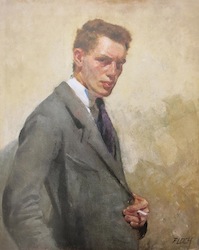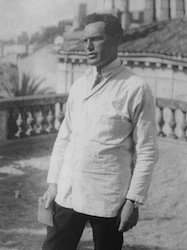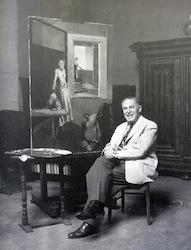Biography

Joseph Floch was born on November 5, 1895, the son of Samuel and Jenny Floch, in Vienna. From 1913 to 1918 he attended the Allgemeine Malschule with Rudolf Bacher, Franz Rumpler and Hans Tichy at the Academy of Fine Arts in Vienna. In 1916 into 1917 Floch served in the military. In 1918 he visited the Pinakothek in Munich where the works of Cézanne, Vincent van Gogh and Hans von Marées deeply affected him. In 1922 to 1938 Floch was member of the Wiener Hagenbund. He became acquainted with the art critics Hans and Erika Tietze. In 1923 Floch spent six months studying in Palestine and followed that in 1924 with travels to Paris, Utrecht, and Stuttgart.
In 1925, after travel to Milan, Cannes, and St. Tropez, Josef Floch emigrated to France, settling in Paris, then the art center of Europe. His long-term friend from Vienna, Willy Eisenschitz, introduced him to the leading French art circle and the artist quickly established himself. Floch also got to know the renowned gallery owner Berthe Weill who promoted the work of Picasso and Modigliani. In 1926 Floch participated in exhibitions in the Salon des Tuileries, the Salon du Franc, and the Salon d'Automne. In 1931 he exhibited at the Crillon Gallery in Philadelphia and the Albertina in Vienna acquires some of his drawings.

On May 12, 1934 Josef Floch married Hermine Fränkl and traveled to London. On March 1, 1935 their first daughter, Jenny Eva, was born. In 1926 the Jeu de Paume Museum bought two of his paintings in Paris. On June 4, 1939 their second daughter, Suzanne Marguerite, was born.
In 1941, because of his Jewish background, Floch and his family were forced to emigrate to the United States. On August 8th they traveled via Turenne, Tarbes, and Madrid to Seville, where they continue by boat to New York. Once in the United States the artist rapidly met with further success. In 1941 he work was exhibited at the Toldeo Museum of Art in Ohio. From 1942 to 1956 he participated in exhibitions in the Associated American Artists in New York. The next year, in 1943, he moved to a new studio on Broadway. In 1944 he was awarded the Lippincott Prize by the Pennsylvania Academy of Fine Arts. In 1945 he had exhibitions at the Whitney Museum of American Art and the Washington County Museum of Fine Art. In 1947 he returned for stays in Paris, Avignon, Les Beaux, and Basel.
In 1951 Floch became an American citizen. Around this time he met Albert Einstein in San Francisco and in 1953 had an exhibition at the De Young Memorial Museum in San Francisco. In 1955 he was awarded the Brevoort Eickemeyer Prize at Columbia University. In 1952 the Belvedere in Vienna acquires Floch’s painting "Figuren auf einem Terrasse.” In 1956 Floch received France’s highest prize, the Legion of Honour. That same year he exhibited at the Drouant-David Gallery in Paris. In May 1956 he visited the painter Edward Hopper. In 1959 Floch moved to the New York’s Upper West Side neighborhood in Manhattan.

In 1962 the artist became a member of the New School for Social Research. In 1963 he was awarded Chevalier member of the Ordre des Arts et des Lettres of France as well as made a member of the Academy of Design. In 1964 Floch’s work was exhibited at the Museum of the University of Syracuse, New York. In 1967 he received the Medal of Merit in New York. In 1972 he traveled to Vienna where, together with Hans Aurenhammer, Floch was presented in the Upper Belvedere and The Albertina and Galerie Zacke acquire several works. On October 26, 1977 Joseph Floch died in New York.
Josef Floch focused on landscape and figure painting. He mainly concentrated on monumental compositions with people, often nudes, in simple positions. An impression of timelessness, calm and harmony is created by subdued colours. During his life time the painter participated in numerous exhibitions and received many prizes and tributes. Works by him are now found in numerous collections, including the Belvedere in Vienna and the Museum Niederösterreich in St. Pölten.
